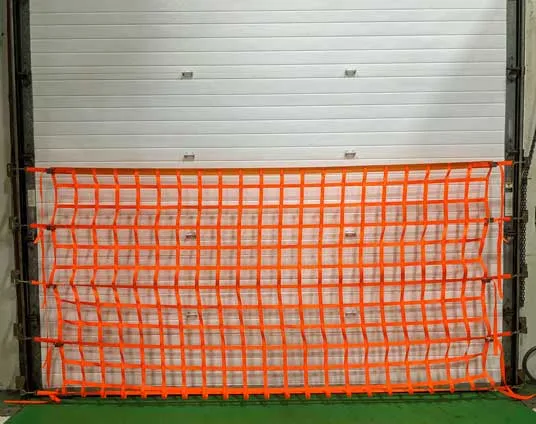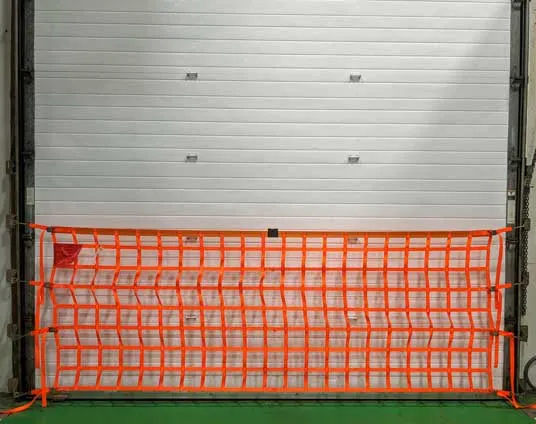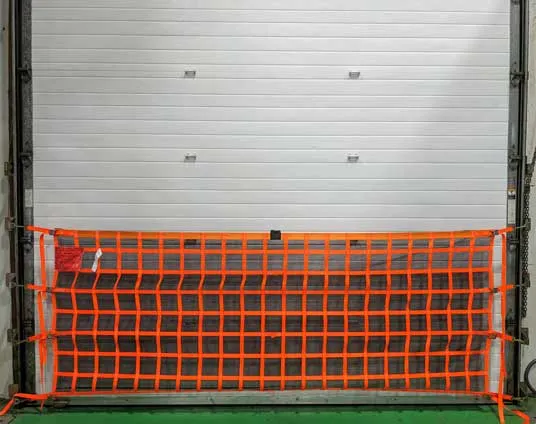Wall Mounted Loading Dock Safety Barrier
During warm months, warehouse temperatures can rise, causing employee discomfort. Such issues can result in a decrease in employee productivity and morale.
For this reason, it is not uncommon for warehouses to open their loading dock doors to allow for airflow.
The two most common dock styles include a ramp with a door flush to the ground or a 4 feet steep drop. Unfortunately, both designs pose a risk of a loading dock accident.
When a loading dock is flush to the ground, businesses risk civilians walking into the warehouse. It is dangerous for civilians to walk into a warehouse they are not equipped or welcome to be in. An injury of the civilian could be at fault of the business, causing danger for all parties.
OSHA requires a guardrail safety system when a loading dock contains a 4 feet drop. Without a system in place, an employee risks falling off the edge.
Loading dock fall protection is the perfect solution for preventing such accidents. Also, allowing employees to feel safe at work and breathe fresh air is the best way to improve morale.
Wall Mounted Loading Dock Net Selection Guide
4 Feet High Standard Dock Net
If you are looking for an economical solution to bring your warehouse up to date on OSHA requirements and do not need an impact barrier, our 4 feet-high standard dock net is right for you. This product can prevent non-motorized hand carts from falling, but to stop a forklift, this product is not our best option.
If you need a loading dock safety net to prevent forklift accidents, click here.
4 Feet High with Debris Liner Dock Net
If you are looking for a solution that will bring your warehouse up to date on OSHA requirements and prevent debris from entering your warehouse, our 4 feet-high dock net with debris liner is right for you. This product also acts to avoid air contamination in your warehouse.
6 Feet High Standard Dock Net
If you are looking for a strategic solution to prevent civilians from walking into your warehouse and you are ensuring that OSHA requirements are met, our 6 feet-high standard dock net is right for you. This product also provides an excellent way for doors to be open during warmer months without the risk of accidents.
Workplace productivity, morale, and safety are achievable with every product kit.
"Nothing but net" is absent from our vocabulary. When you order a dock net kit, all hardware is included:
Four Feet Wall Mount Loading Safety Net
(1) 4 feet dock safety net with your choice of debris lining or no lining
(8) 3 feet adjustable straps
(8) snap hooks
(8) cam buckles
(8) wall brackets* for installation
Six Feet Wall Mount Loading Safety Net
(1) 6 feet dock safety net:
(10) 3 feet adjustable straps
(10) snap hooks
(10) cam buckles
(10) wall brackets* for installation
*Wall brackets have a notch that the net can hang on; this prevents a tripping hazard.
Managers, you can now relax when that new hire pushes your product too close to the edge.
OSHA Loading Dock Fall Protection Requirements
Meeting OSHA requirements was a priority when we custom engineered our dock nets. Likewise, transforming warehouses from dangerous to safe was our mission. By achieving both, our product promotes dock door fall protection in a quick-to-install noninvasive manner.
A guardrail barrier in place prevents employees from falling to the lower level. Our loading dock system does precisely that.
We did not design our loading dock barrier based solely on our safety requirements. We engineered our product based on OSHA loading dock requirements.
OSHA's regulations specify that the top edge of the guardrail system must be 42 inches +/- three inches. Additionally, it can exceed 45 inches as long as every other standard of criteria is in place.
According to OSHA, guardrail systems must withstand a downward force of 200 lbs. Failure to resist this force within 2 inches of the top edge does not meet requirements. The guardrail system should not deflect to a height below 39 inches at any time.
Our product was engineered specifically to meet OSHA requirements for guardrail and fall safety.
1910.28(b)(1)
Unprotected sides and edges.
1910.28(b)(1)(i)
Except as provided elsewhere in this section, the employer must ensure that each employee on a walking-working surface with an unprotected side or edge that is 4 feet (1.2 m) or more above a lower level is protected from falling by one or more of the following:
1910.28(b)(1)(i)(A)
Guardrail systems;
1910.28(b)(1)(i)(B)
Safety net systems; or
1910.28(b)(1)(i)(C)
Personal fall protection systems, such as personal fall arrest, travel restraint, or positioning systems.
Standard number 1910.28 and all that it involves can be found here.
Walking-Working Surfaces - Fall protection systems and falling object protection-criteria and practices
1910.29(b)(1)
The top edge height of top rails, or equivalent guardrail system members, are 42 inches (107 cm), plus or minus 3
inches (8 cm), above the walking-working surface. The top edge height may exceed 45 inches (114 cm), provided the
guardrail system meets all other criteria of paragraph (b) of this section (see Figure D-11 of this section).
1910.29(b)(4)
When the 200-pound (890-N) test load is applied in a downward direction, the top rail of
the guardrail system must not deflect to a height of less than 39 inches (99 cm) above the
walking-working surface.
Standard number 1910.29 and all that it involves can be found here.
How Our Dock Net Meets Dock Door Fall Protection Regulations
Our loading dock nets are 48 inches tall, meeting every safety regulation. The achieved goal of maximizing dock and guardrail safety is present in every dock net.
The product does not deflect under pressure, and the resting height is 42 inches for the four-feet product and 72 inches for the six-feet product. Neither net deflects below 39 inches, which meets OSHA's height requirements.
In each kit, brackets are provided to ensure that they can be properly installed at regulation height.
Fall protection is our goal while meeting OSHA requirements is a priority. Each net meets OSHA regulations and enhances safety for your loading dock.









